Table of Contents
Guide
Page List
 About the AuthorsDennis Donovan
About the AuthorsDennis Donovan has been a math teacher at Xaverian Brothers High School for more than 25 years, teaching AP Calculus, both AB and BC, for more than 20 years. He has served as an AP Calculus Reader and as one of nine national Question Leaders for the AP Calculus exam. Dennis leads professional development workshops for math teachers as a consultant for the College Board and a T3 Regional Instructor for Texas Instruments.
David Bock taught AP Calculus during his 35 years at Ithaca High School, and served for several years as an Exam Reader for the College Board. He also taught mathematics at Tompkins-Cortland Community College, Ithaca College, and Cornell University.
IN MEMORIAMShirley O. IN MEMORIAM Shirley O.
Hockett(1920 2013)Shirley Hockett taught mathematics for 45 years, first at Cornell University and later at Ithaca College, where she was named Professor Emerita in 1991. An outstanding teacher, she won numerous awards and authored six mathematics textbooks. Shirleys experiences as an Exam Reader and Table Leader for AP Calculus led her to write the first ever AP Calculus review book, published in 1971. Her knowledge of calculus, attention to detail, pedagogical creativity, and dedication to students continue to shine throughout this book. On behalf of the thousands of AP Calculus students who have benefited from her tireless efforts, we gratefully dedicate this review book to Shirley. Copyright 2019, 2017, 2015, 2013, 2012, 2010, 2008 by Kaplan, Inc., d/b/a
Barrons Educational Series
Prior editions Copyright 2005, 2002, 1998 by Kaplan, Inc., d/b/a Barrons Educational Series under the title How to Prepare for the AP Advanced Placement Examination in Calculus and 1995, 1992, 1987, 1983, 1971 under the title How to Prepare for the Advanced Placement Examination: Mathematics.
All rights reserved under International and Pan-American Copyright Conventions. By payment of the required fees, you have been granted the non-exclusive, non-transferable right to access and read the text of this eBook on screen. No part of this text may be reproduced, transmitted, downloaded, decompiled, reverse engineered, or stored in or introduced into any information storage and retrieval system, in any form or by any means, whether electronic or mechanical, now known or hereinafter invented, without the express written permission of the publisher. Published by Kaplan, Inc., d/b/a Barrons Educational Series 750 Third Avenue New York, NY 10017 www.barronseduc.com ISBN: 978-1-5062-7192-7 International Standard Serial No.: 1940-3089 10 9 8 7 6 5 4 3 2 1
Contents
As you review the content in this book to work toward earning that on your AP CALCULUS
AB exam, here are five things that you MUST know above everything else:
Learn the basic facts: derivatives () of common functions; the Product () for finding derivatives; the midpoint, left and right rectangle, and trapezoid approximations for estimating definite integrals (); finding antiderivatives by substitution (); the important theorems: Rolles Theorem (). (Barrons
AP Calculus Flashcards are another great way to study these!)
Understand that a derivative is an instantaneous rate of change, and be able to apply that concept to: using LHospitals Rule to find limits of indeterminate forms (only00and) (); find equations of tangent lines (); determine where a function is increasing/decreasing (); analyze the speed, velocity, and acceleration of an object in motion (); solve related rates problems () when necessary.
Be able to apply any of the above calculus concepts to functions defined algebraically, graphically, or in tables.Be able to maximize your score on the exam by: answering
all the multiple-choice questions; knowing how and when to use your calculator, and when not to; understanding what work you need to show; knowing how to explain, interpret, and justify answers when a question requires that. (The free-response solutions in this book model such answers.) As you review the content in this book to work toward earning that on your AP CALCULUS
BC exam, here are five things that you MUST know above everything else:
Master the Essential 5 listed for the AB Calculus Exam. These form the core for questions that determine your AB subscore, and provide the essential knowledge base youll need for questions related to the additional BC topics.
Understand how to extend AB Calculus concepts to more advanced situations, including: using limits to analyze improper integrals (); solving logistic differential equations (); finding antiderivatives using integration by parts (); finding length of curve (arc length) ().
Be able to apply calculus concepts to parametrically defined functions ().Know how to analyze the position, velocity, speed, acceleration, and distance traveled for an object in motion in two dimensions by applying calculus concepts to vectors ().Understand infinite series. You must be able to: determine whether a series converges or diverges (); use Taylors theorem to represent functions as power series (); determine the interval of convergence for a power series (); find bounds on the error for estimates based on series ().
Be able to apply calculus concepts to parametrically defined functions ().Know how to analyze the position, velocity, speed, acceleration, and distance traveled for an object in motion in two dimensions by applying calculus concepts to vectors ().Understand infinite series. You must be able to: determine whether a series converges or diverges (); use Taylors theorem to represent functions as power series (); determine the interval of convergence for a power series (); find bounds on the error for estimates based on series ().
T his book is intended for students who are preparing to take either of the two Advanced Placement examinations in Mathematics offered by the College Board, and for their teachers. It is based on the curriculum framework published by the College Board, effective Fall 2019, and covers the topics listed there for both Calculus AB and Calculus BC. Calculus AB and BC are both full-year courses in the calculus of functions of a single variable. Both courses emphasize: (1) student understanding of concepts and applications of calculus over manipulation and memorization; (2) developing the students ability to express functions, concepts, problems, and conclusions analytically, graphically, numerically, and verbally, and to understand how these are related; and (3) using a graphing calculator as a tool for mathematical investigations and for problem-solving. Both courses are intended for those students who have already studied college-preparatory mathematics: algebra, geometry, trigonometry, analytic geometry, and elementary functions (linear, polynomial, rational, exponential, logarithmic, trigonometric, inverse trigonometric, and piecewise). Limits, 2. Limits, 2.
Derivatives, 3. Integrals and the Fundamental Theorem, and 4. Series. The AB exam tests content areas 1, 2, and 3. The BC exam tests all four content areas. There are BC-only topics in content areas 2 and 3, as well.
Roughly 40 percent of the points available for the BC exam are BC-only topics. Content Area 1: Limits Limits are used in many calculus concepts to go from the discrete to the continuous case. Students must understand the idea of limits so that a deeper understanding of definitions and theorems can be achieved. Students must be presented with different representations of functions when calculating limits. Working with tables, graphs, and algebraically defined functions with and without the calculator are essential skills that students need to master.

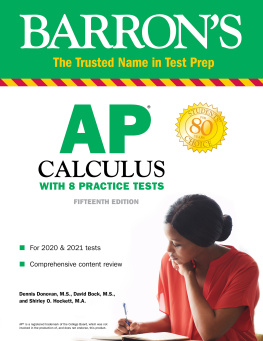

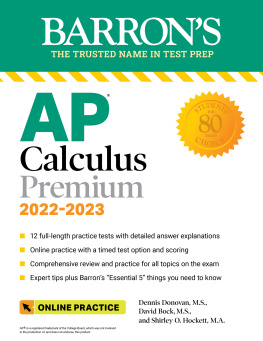


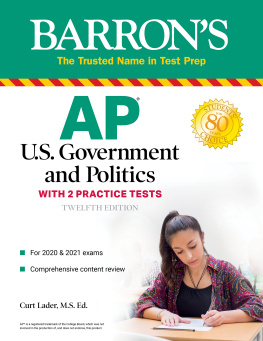
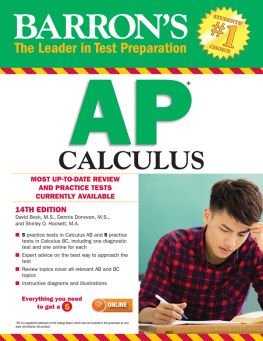
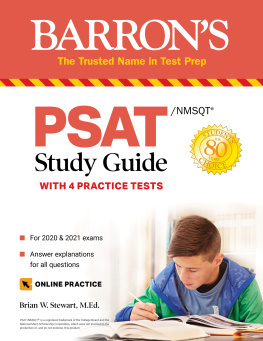

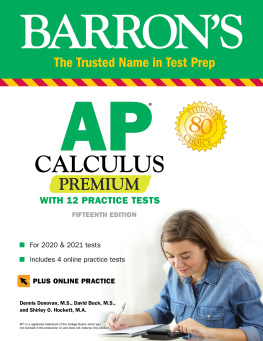
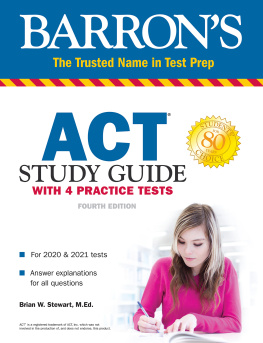
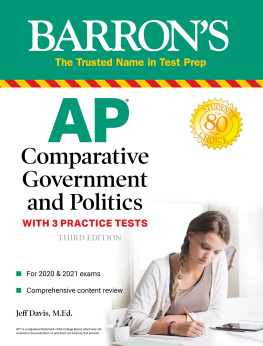
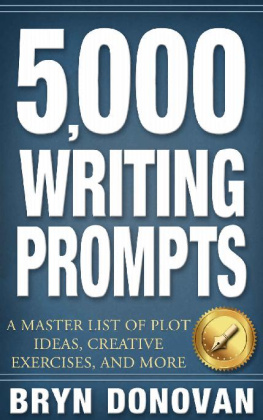

 About the AuthorsDennis Donovan has been a math teacher at Xaverian Brothers High School for more than 25 years, teaching AP Calculus, both AB and BC, for more than 20 years. He has served as an AP Calculus Reader and as one of nine national Question Leaders for the AP Calculus exam. Dennis leads professional development workshops for math teachers as a consultant for the College Board and a T3 Regional Instructor for Texas Instruments. David Bock taught AP Calculus during his 35 years at Ithaca High School, and served for several years as an Exam Reader for the College Board. He also taught mathematics at Tompkins-Cortland Community College, Ithaca College, and Cornell University. IN MEMORIAMShirley O. IN MEMORIAM Shirley O.
About the AuthorsDennis Donovan has been a math teacher at Xaverian Brothers High School for more than 25 years, teaching AP Calculus, both AB and BC, for more than 20 years. He has served as an AP Calculus Reader and as one of nine national Question Leaders for the AP Calculus exam. Dennis leads professional development workshops for math teachers as a consultant for the College Board and a T3 Regional Instructor for Texas Instruments. David Bock taught AP Calculus during his 35 years at Ithaca High School, and served for several years as an Exam Reader for the College Board. He also taught mathematics at Tompkins-Cortland Community College, Ithaca College, and Cornell University. IN MEMORIAMShirley O. IN MEMORIAM Shirley O.